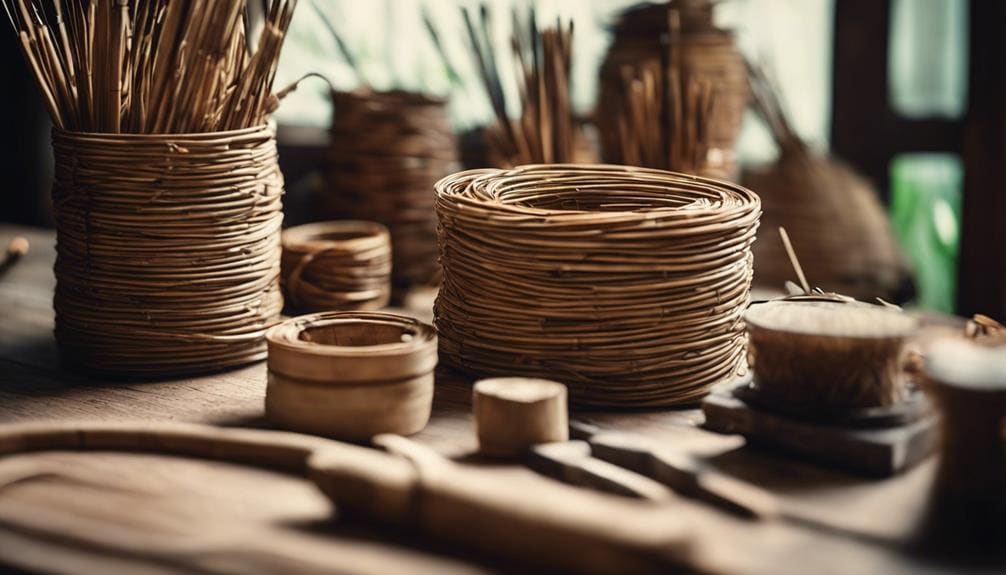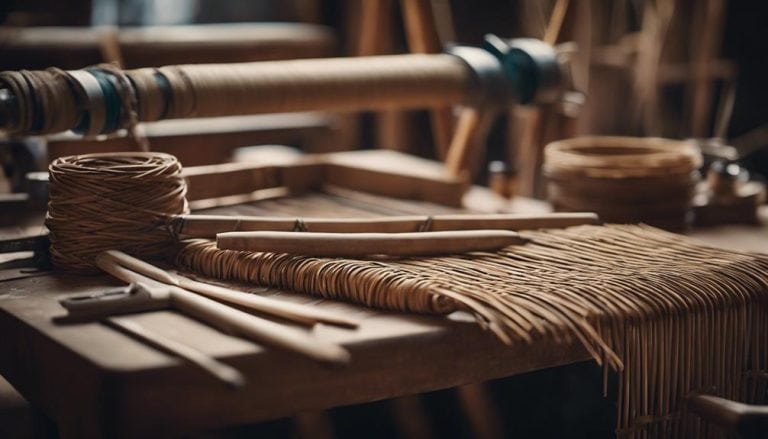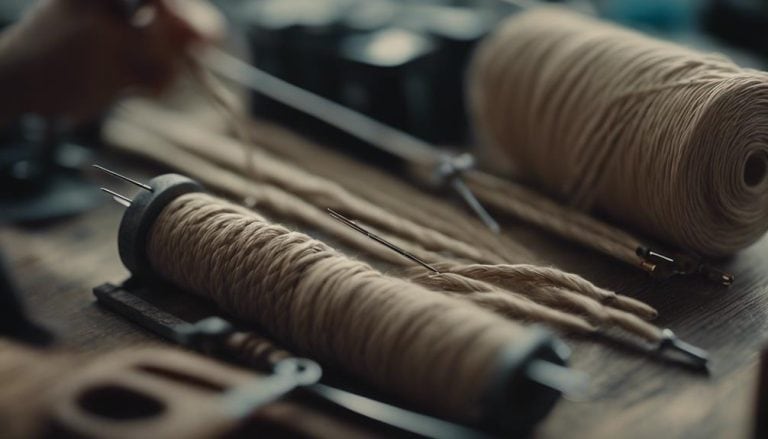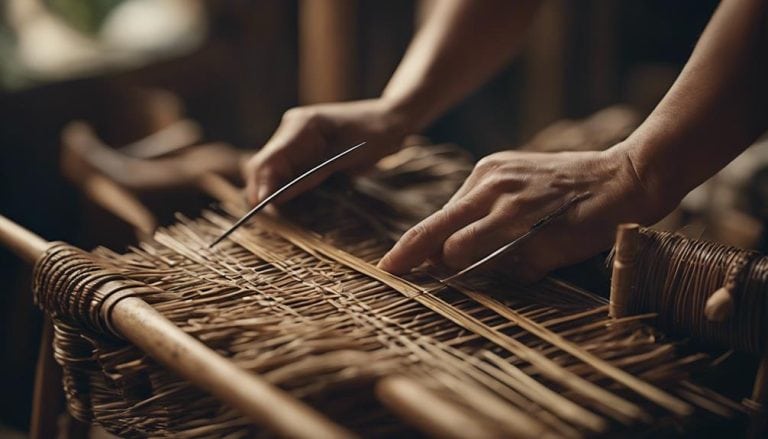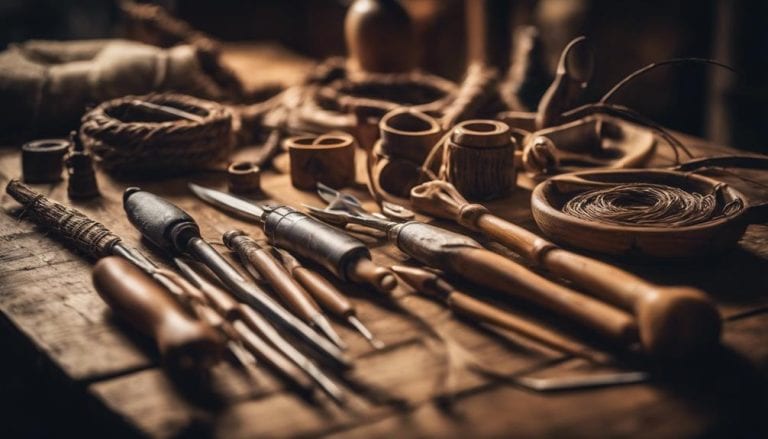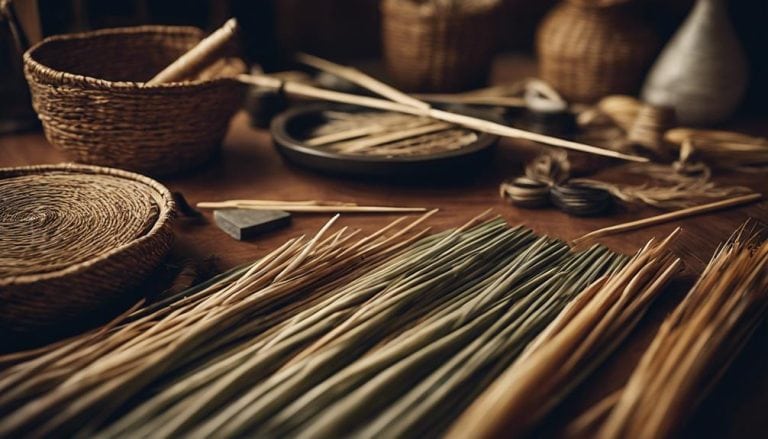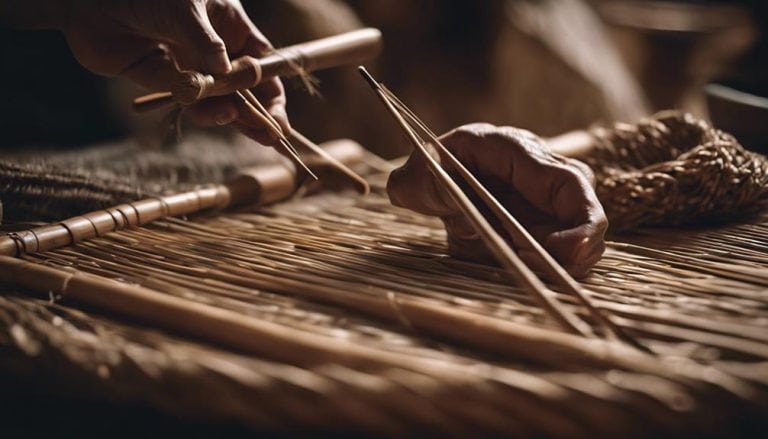List of Equipment for Rattan Weaving
As a seasoned weaver, navigating the realm of rattan weaving requires precision and preparedness. The plethora of tools, from sharp scissors to specialized spoke weights, sets the stage for crafting intricate pieces. But what about the lesser-known essentials that could elevate your craft to new heights? Join me in exploring the depths of rattan weaving equipment, where even the simplest tool can unlock a world of creativity and innovation.
You’ll need a rattan cutter and a weaving frame for rattan weaving. These tools are essential for crafting rattan furniture and decor.
Key Takeaways
- Essential tools like rattan scissors and packing tools are crucial for clean cuts and maintaining tension.
- Basic equipment such as rattan cutters and awls are needed for preparation and creating weaving holes.
- Specialized weaving tools like rattan peelers and cane splitters offer precision for intricate designs.
- Supplies like sharp basket scissors and spoke weights ensure accuracy and tension maintenance.
Essential Tools for Rattan Weaving
In rattan weaving, precisely selecting and utilizing essential tools are paramount for achieving impeccable craftsmanship. Weaving techniques require rattan scissors, which are crucial for cutting strands cleanly and ensuring accuracy. Carving tools such as knives or Scorps aid in shaping and detailing rattan strands, facilitating intricate designs that elevate the final product. Maintenance tips emphasize the importance of regularly sharpening and cleaning these tools to maintain effectiveness.
When exploring creative designs and color choices, packing tools come into play. These tools help compact and secure woven rattan, ensuring the durability and sturdiness of the finished piece. Additionally, spoke weights are indispensable for maintaining consistent tension throughout the weaving process, contributing to the rattan creation’s structural integrity and overall quality. By understanding the roles of these essential tools and incorporating them skillfully, one can unleash their creativity and produce exceptional rattan weavings.
Basic Equipment Needed
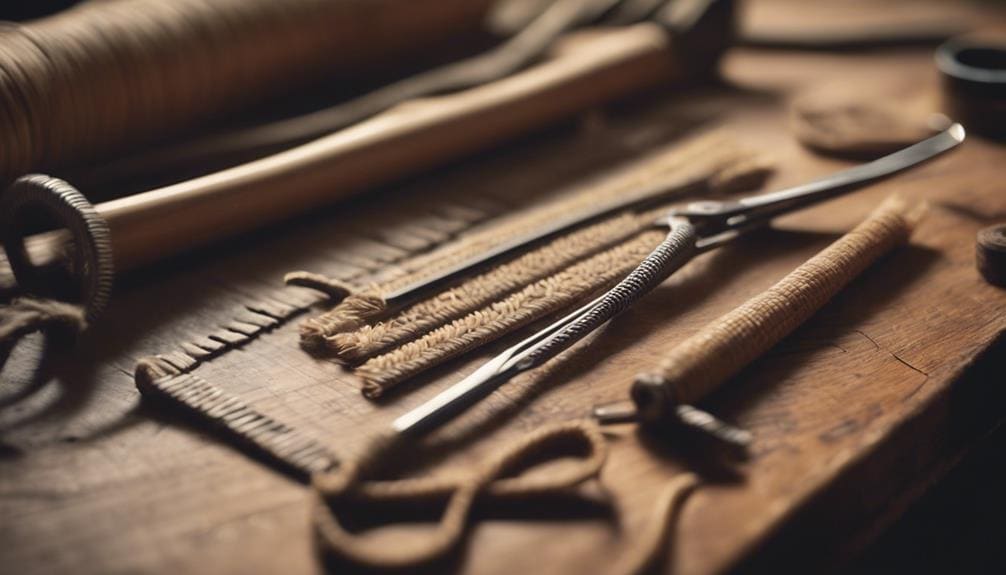
To create impeccable rattan weavings, one must have basic equipment, including rattan cutters, awls, packing tools, spoke weights, sharp scissors, side cutters, and needle nose pliers. These tools are essential for mastering various weaving techniques and ensuring precise material selection. Rattan cutters are crucial for trimming and preparing rattan strands, while awls help create holes for weaving intricate patterns.
Packing tools and spoke weights maintain tension throughout weaving, resulting in sturdy and well-formed designs. Sharp scissors and side cutters aid in accurately cutting and shaping rattan, while needle nose pliers assist in handling delicate weaving details. Each tool plays a vital role in weaving, allowing beginners and experienced weavers to craft beautiful and durable rattan pieces. By mastering these basic tools, we can unleash our creativity and produce exceptional rattan weavings that showcase our skills and dedication to this intricate craft.
Specialized Weaving Tools
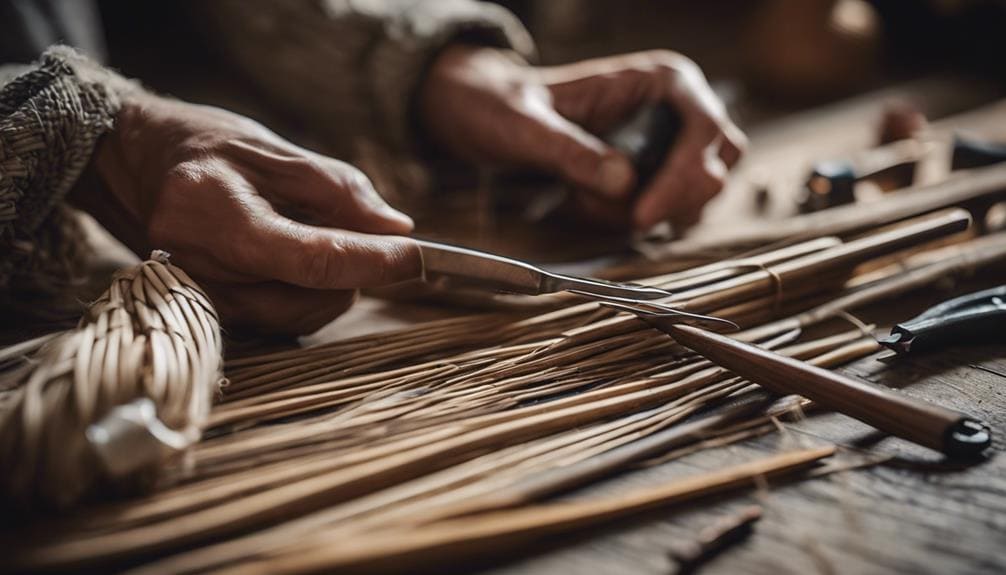
Intricate rattan weaving patterns and designs are meticulously crafted with specialized weaving tools, such as rattan peelers, awls, cane splitters, and reed cutters. These tools are crucial in preparing and manipulating rattan materials for weaving projects.
Here are some key points to consider when using specialized weaving tools:
- Precision is Key: Each tool serves a specific purpose in weaving, from stripping the outer skin of rattan poles to shaping and trimming rattan strips. Understanding how to use these tools correctly ensures the quality and durability of your weaving projects.
- Enhancing Creativity: Experiment with different weaving techniques and color combinations to create unique patterns and designs. The right tools can help bring your creative vision to life, allowing you to explore new possibilities in rattan weaving.
- Maintenance Tips: Proper maintenance of your weaving tools is essential for longevity and effectiveness. Regular cleaning, sharpening, and storage will ensure they remain in top condition for all your weaving endeavors.
Must-Have Supplies
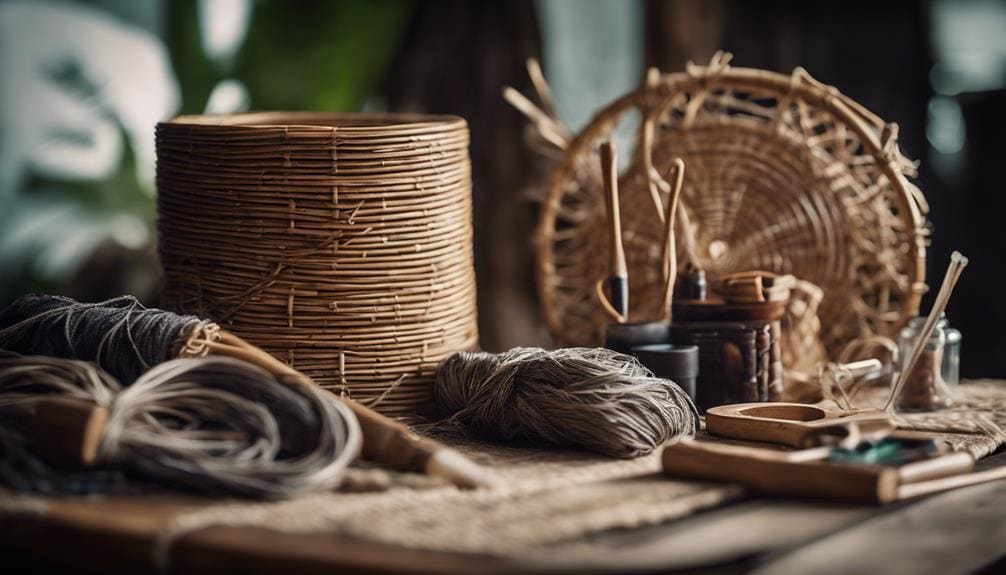
When selecting supplies for rattan weaving projects, prioritizing essential tools like sharp basket scissors, a reliable packing tool, an awl, spoke weights, and sharp angle cutters is crucial for achieving precise and intricate designs. Sharp basket scissors are indispensable for cutting rattan strips accurately, ensuring clean and neat edges in complicated patterns.
A good packing tool is vital to compact and secure the weaving material, maintaining the structure and durability of the final piece. An awl is a must-have tool for creating holes in the rattan, facilitating weaving techniques, and allowing for creative designs. Spoke weights play a crucial role in maintaining tension and shape while working on complex patterns, aiding in executing expert tips for a professional finish.
Additionally, sharp angle cutters prove invaluable for trimming excess material and achieving flawless finishes, enhancing the overall aesthetic of rattan weaving projects. Selecting the right tools is essential for material selection and mastering various weaving techniques to create unique and artistic designs.
Additional Rattan Weaving Tools
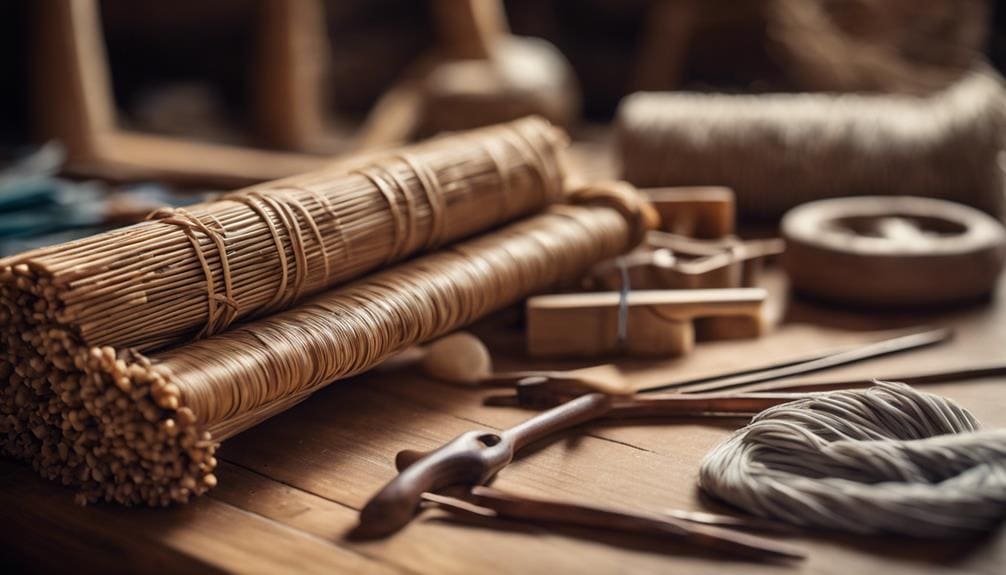
As we explore the realm of additional rattan weaving tools, one can expand one’s arsenal beyond the must-have supplies to include specialized tools for specific weaving techniques and enhancements.
- Packing tools and lashing tools: Essential for ensuring a tight weave and securing joints, packing tools and lashing tools play a crucial role in the structural integrity of rattan furniture pieces.
- Reed splints and caning accessories: Utilizing reed splints such as flat reed splint, flat oval reed splint, and round reed can elevate your weaving projects to new levels of intricacy. Accessories like chair caning combs and cane insertion tools are indispensable for achieving professional-quality finishes.
- Customization and Modernization: Craftsmen often adapt traditional tools or incorporate modern, automated tools to enhance productivity and precision in rattan weaving. Embracing customization and modernization allows for innovative techniques and streamlined workflows, empowering artisans to push the boundaries of traditional rattan craftsmanship.
Tools for Finishing Touches
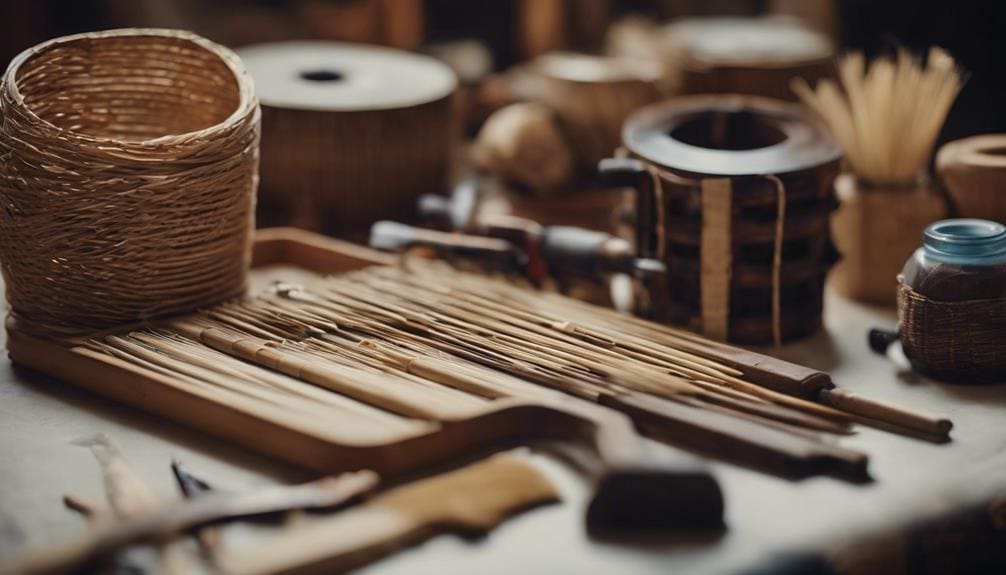
I meticulously select the tools for adding the final touches to rattan weaving projects, ensuring each detail contributes to the desired decorative and functional outcome. When it comes to color application and design techniques, using black and brown hues can transform rattan furniture into stunning art pieces. Applying varnish post-weaving not only enhances the aesthetic appeal but also provides a glossy finish that elevates the overall look of the furniture. Kalikatte, a versatile tool for bending rattan stems, is crucial in crafting intricate designs that add a unique touch to the woven furniture.
Nails are indispensable for securing joints and ensuring durability in rattan furniture. These small but mighty fasteners keep the structure intact, guaranteeing long-term stability. Additionally, tools like hammers are essential for nailing and shaping rattan pieces, aiding in creating decorative details that make each project stand out. With the right tools and techniques, rattan weaving finishing touches can bring a sense of artistry and sophistication to the final product.
Advanced Equipment for Experienced Weavers
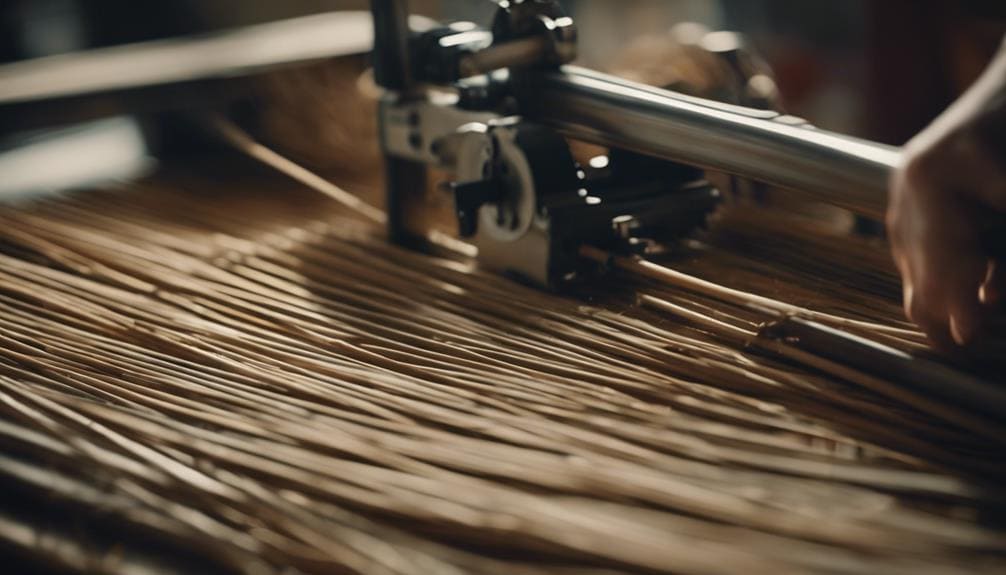
To elevate their craftsmanship and tackle intricate designs, experienced weavers invest in advanced equipment tailored to enhance precision and efficiency in rattan weaving projects. When delving into the realm of advanced rattan weaving, the following specialized tools can significantly aid seasoned weavers in achieving optimal results:
- Precision Weaving Tools: Advanced weavers often rely on precision weaving tools with intricate designs to execute complex weaving patterns with finesse and accuracy. These tools allow for detailed, elaborate designs showcasing the weaver’s expertise and creativity.
- Customized Weaving Tools: Experienced weavers may opt for customized tools that cater to their specific weaving styles and preferences. These tailored tools ensure the weaver can work comfortably and efficiently, leading to superior results in their rattan weaving projects.
- High-Speed Weaving Machine: Investing in a high-speed weaving machine can greatly increase productivity and efficiency for advanced weavers. This advanced equipment allows for faster weaving processes without compromising the quality of the final product, enabling weavers to take on intricate projects with ease.
Frequently Asked Questions
How Do You Prepare Rattan for Weaving?
To prepare rattan for weaving, I pre-soak it in water for flexibility and then employ drying techniques to ensure it’s ready for crafting. This process is essential for ensuring the rattan is pliable and easy to work with.
What Is Used to Make Rattan Furniture?
Artisans use knives, brushes, blow torches, chisels, and hammers to craft rattan furniture. With an emphasis on sustainability in rattan sourcing and innovative designs, each piece showcases detailed craftsmanship and a glossy finish.
What Are the Different Types of Rattan Weave?
When exploring rattan weave, you’ll encounter diverse patterns like herringbone, checkerboard, twill, and hexagonal designs. Various weaving techniques result in flat, round, or twisted weaves, creating unique textures. These distinctions provide furniture with differing levels of strength and flexibility.
What Is the Best Material for Weaving Outdoor Chairs?
Synthetic rattan, crafted from polyethylene or PVC, is the best choice for weaving outdoor chairs. Its durability, weather resistance, and minimal maintenance make it a practical and stylish option for any outdoor setting.
Conclusion
As I put down my tools after a long day of weaving, I am reminded of the intricate dance between craftsmanship and creativity. Like a symphony conductor, each tool plays its part in creating a masterpiece of rattan artistry. The sharp scissors, precise cutters, and delicate awls all unite harmoniously, weaving a tapestry of tradition and innovation. In a skilled weaver’s hands, these tools become magic wands, transforming simple rattan into exquisite works of art.

